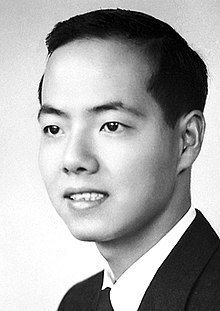Tsung-Dao Lee
| Tsung-Dao Lee | ||
|---|---|---|
 | ||
| Información personal | ||
| Nombre en chino | 李政道 | |
| Nacimiento |
24 de noviembre de 1926 Shanghái, China | |
| Fallecimiento |
4 de agosto de 2024 (97 años) San Francisco (Estados Unidos) | |
| Nacionalidad | Estadounidense (desde 1962) | |
| Familia | ||
| Padre | Tsing Kong Lee | |
| Cónyuge | Jeannette Hui-Chun Chin | |
| Educación | ||
| Educado en |
| |
| Supervisor doctoral | Enrico Fermi | |
| Información profesional | ||
| Ocupación | Físico, profesor universitario y físico teórico | |
| Área | Física de partículas, física y física teórica | |
| Empleador |
| |
| Afiliaciones | Organización Europea para la Investigación Nuclear | |
| Miembro de | ||
| Distinciones |
| |
| Firma |
 | |
Tsung-Dao Lee 李政道 (Shanghái, 24 de noviembre de 1926-San Francisco, California, 4 de agosto de 2024)[1] fue un físico chino cuyas teorías guiaron la investigación de la física nuclear durante la segunda mitad del siglo XX. Encontró incoherencias en el principio de paridad e inició el desarrollo de una teoría unificadora de la naturaleza de las partículas subatómicas.
En 1957 recibió, junto a Chen Ning Yang, el premio Nobel de Física por sus trabajos con las partículas subatómicas.
Véase también
[editar]- El libro de divulgación científica The Ambidextrous Universe (publicado con el título Izquierda y derecha en el Cosmos), del estadounidense Martin Gardner, explica al público lego en física el principio de paridad.
Referencias
[editar]- ↑ Redacción (5 de agosto de 2024). «Physics Nobel laureate Tsung-Dao Lee dies at 98». China Daily (en inglés). Consultado el 5 de agosto de 2024.
Enlaces externos
[editar] Wikimedia Commons alberga una galería multimedia sobre Tsung-Dao Lee.
Wikimedia Commons alberga una galería multimedia sobre Tsung-Dao Lee. Wikiquote alberga frases célebres de o sobre Tsung-Dao Lee.
Wikiquote alberga frases célebres de o sobre Tsung-Dao Lee.
Text is available under the CC BY-SA 4.0 license; additional terms may apply.
Images, videos and audio are available under their respective licenses.
